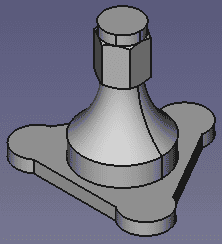
Once the offsets have been set and locked, the B-Splines are drawn to intersect the offset points. L2S5 - my naming convention for L2 waterline intersecting Station 5. Then the length of each line is constrained and the length constraint is named - e.g. Here is the view of Station 5 - the midway station:Įach Offset value is determined by moving the end of the frame line in and out until the point lies on the line in the plan. The length of each line is not constrained in the master but is in the individual station sketches. The elevation value constraints are named (alias) with the lift identity L1, L2 etc and can be reused within the model in the actual station sketches. The other constraint is the elevation above the origin.
Freecad mirror full#
This allows me to build the model as a full hull rather than half hull. The lines are constrained as symetrical about the vertical (z) axis. Here is the view of the master station frame in the Sketcher. These constrained construction lines were copied from a master frame sketch for stations and one for waterlines. Then I created sketches at each station (plus a couple at the deck step I will explain later) and at each waterline with constrained construction lines at their intersection. I started by bringing in the plans using the image workbench and arranging the three views on the planes and aligning them. Kris - I liked your start and wanted to keep up with your posts. I tried to get thte ship module working and failed - no blame allocation as it could have been my understanding. My tree-view of this model also lacks structure and that makes it difficult to keep track of more then 300 points already.Ĭonclusion: I will try to start over the effort and use sketches from the start. I think you can only get that by using sketches that import these intersection points from external geometry (sorry if this sounds very FreeCAD slang). My network of curves, that looks quite OK visually, is far from a real network because intersection points of horizontal and vertical curves are actually not coincident. That was a disappointment and only resulted in errors.
Freecad mirror skin#
I wanted to use the Gordon-surface tool from the curves workbench to skin the network of curves. I made curves through these points both with draft splines and the tools from the curves workbench.

The next picture shows this more clearly. Vertically they follow the location of the stations. They are arranged horizontally along the waterlines, half-breadth lines, top-timber line and topside. The exact difference between the two kinds is unclear to me. I used both draft points and part vertices.

I must admit that it is a far too complex ship to start with, but my desire to bring such ship to live won from logical reasoning. It is for an English third rate ship (74-gun) from the second half of the 18th century.

I want to share the current state of my FreeCAD work. Hoping that this will be of interest and that others will contribute. I plan to go back and show how this was assembled and then move forward on the issues. I have been inspired by some amazing work in other topics in this forum " CAD and 3D Modelling/Drafting Plans with Software".Īttached is a current rendering with many unresolved issues. The objectives of the project are to understand some techniques for getting the 3D hull built, to get as realistic rendering as possible, and explore the opportunities for 3D printing with various options. At some point photographs of the real schooner will resolve details. The project used as an example is a hull model of the New England fishing schooner Adventure and supporting information from and details from Howard Chapelle's "The American Fishing Schooner". Being relatively new to the 3D CAD scene, the approaches will be relatively simple and sometimes wrong and can be improved. Starting this topic to explore the FreeCAD program and discuss techniques to be used.


 0 kommentar(er)
0 kommentar(er)
